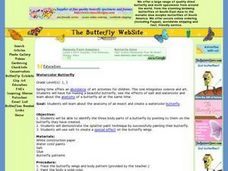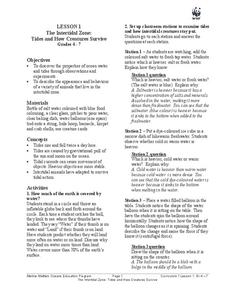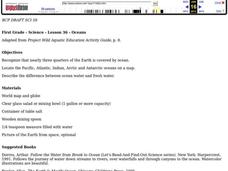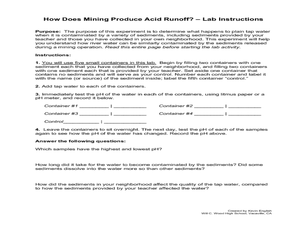Curated OER
UMNH: Cultural Clutter - Tales In The Trash
Fourth graders list three or more types of evidence of prehistoric cultures that encouraged archaeologists to investigate the marshes around the Great Salt Lake. They also explain why it is important not to disturb archaeological remains.
Curated OER
Coal Flowers
Students observe the effect of various chemicals on coal. Using coal, laundry bluing, water, salt, and ammonia, they observe crystal formations after a period of a few hours, and discuss their observations.
Curated OER
Beaches of the Delaware Estuary
Middle schoolers examine estuaries in Delaware. They, in groups, gather samples of water to find organisms and identify them.
Curated OER
Magneto-hydrodynamic Drives
Students examine how electric and magnetic fields can be used to force water out of a chamber to move a vehicle forward.
Curated OER
Watercolor Butterfly
Students identify and analyze the anatomy of an insect and create a watercolor butterfly. They identify the three body parts of a butterfly by pointing to them on the butterfly they have created and demonstrate the splatter paint...
Curated OER
Science: Quick Freeze
Learners observe an experiment of freezing point depression using club soda. Through observation, they note that the carbon dioxide molecules disrupt the capacity of the water molecules to solidify. Precautions must be taken to assure...
Curated OER
Bouncing Popcorn
Third graders meet a teacher challenge to work like chemists. They investigate with baking soda, water, salt, sugar, vinegar, and sprite to move a popcorn kernel from the bottom of a cup to the top. They experiment with different...
Curated OER
The Intertidal Zone: Tides and How Creatures Survive
Young scholars study the properties of ocean water and tides and learn about animals that live in intertidal zones. In this intertidal zone instructional activity, students participate in classroom stations to learn about fresh water and...
Curated OER
Oceanography
Second graders identify saltwater and freshwater habitats and the resources found in them. They compare and contrast the two habitats and discuss their findings. They discover the resources bodies of water can provide.
Curated OER
Oceans
First graders recognize that nearly three quarters of the Earth is covered by ocean. They locate the Pacific, Atlantic, Indian, Arctic and Antarctic oceans on a map. They describe the difference between ocean water and fresh water.
Curated OER
Section 1: Non-obvious Causes
Students explore the historical problem of pumping water out of mines.
Curated OER
Dietary Fiber Introduction
Students identify fiber from foods, its sources and function in the body. They also the importance of fiber in the diet and good food sources that one can eat. Finally, students discuss water and its importance with eating fiber and...
Curated OER
Twisters
Learners differentiate between the terms 'tornado watch' and 'tornado warning' and simulate the conditions that produce tornadoes. They read "Night of the Twisters" by Ivy Ruckman and conduct an experiment using two-liter plastic...
Curated OER
Energy Audits for the Elderly
Students perform experiments to determine the nature of energy particularly in air, light and water. They conducted an energy audit using the Energy Audit Checklist and by looking at the school's bills for gas and power.
Curated OER
Jeannette
Learners develop hypothesis about what might happen when salt water is frozen. In groups, they freeze ice samples with different salt concentrations. They use the internet to research the situation of the Jeannette to discover their...
Curated OER
What is an Estuary?
Students define the terms estuary and watershed. They conduct an experiment to determine the density differences between fresh and saltwater. They examine the salinity distribution of the Peconic Bay Estuary.
Curated OER
How Does Mining Produce Acid Runoff?
Students examine how mining and other industry operations can lead to acid runoff. In this mining lesson students study weathering and complete a lab on it.
Curated OER
5th grade science review
In this science review worksheet, 5th graders answer questions about molecules, force, elements, nature, and more. Students complete 25 multiple choice questions.
Exploratorium
Penny Battery
Use pennies to light an LED. Class members follow the provided directions to build a multi-celled battery powered by pennies. Using stacks of pennies of varying heights, pupils control the voltage of the battery to light different colors...
Curated OER
Bacterial growth
Students explore the exponential growth and decay of microbial populations in relation to the organism tolerance ranges in their environment, They observe the impact of changing variables which can affect microbial populations.
Curated OER
Metals and Non-Metals
A table of the physical properties of metals and non-metals opens this high-school chemistry handout. Also covered are the chemical properties of metals and non-metals, reactivity, and fossil fuels. There are no specific questions to...
Curated OER
Texture With Chemical Reactions
Students explore the use of different textures in watercolor paintings in this late-elementary lesson plan. Emphasis is placed upon the art element of texture using the science of chemical reaction. The lesson plan includes one...
Curated OER
"I'm Melting!"
Third and fourth graders engage with a worksheet designed to help them differentiate between melting and dissolving. After reading an informative paragraph about the two actions, they consider four scenarios, and choose whether they...
Virginia Department of Education
Acids and Bases
What did one titration say to the other titration? We should meet at the end point! Young chemists perform four experiments: dilute solution, neutralization, titration, and figuring pH/pOH.

























